Q&A with Photographer JUSTIN FANTL
One of the reasons I write this blog is that it offers me the rare privilege of seeing through the eyes of the photographers and stylists I interview. With each interview, my vision and a sense of discovery is renewed.
Many years ago I had one of those dreams from which one wakes up and thinks ‘hmm.’ I was in an incredibly beautiful garden with colors I had never seen before. I ‘knew’ that this was how the world really looked but that I didn’t see it. This dream and other events marked the beginning of a spiritual search that has taken many turns but has brought me back to my first love, photography, which is, in part, showing me incrementally how to see the world as this beautiful garden and teaching me about the redemptive power of the simple act of seeing.

When Justin Fantl first contacted me simply to tell me he liked POP, my response was ‘thank you’ followed very quickly by a request to interview him. I was very familiar with and loved his work and knew I had to ask a few questions of someone who had so many smart and funny images of taxidermied animals on his site alongside clean and immaculately composed studio and interior shots and landscape and travel work shot with the eye of a real traveler, one who is really present with and reveals a new side to the place he is visiting.
So while he wrapped up his final tour with Or, The Whale he also managed to write a sincerely thoughtful and inspiring interview for POP in which we get a peek into what is behind the sense of awe and humor that pervades his work and the technical and conceptual foundation that has helped him achieve early success and build a diverse portfolio of still, interior, landscape, and travel work.
Represented by Apostrophe, Fantl is an advertising and editorial photographer whose client list includes The New York Times T Magazine, Dwell, Fortune, Scientific American, Popular Mechanics, The Wall Street Journal, San Francisco Magazine, Wieden + Kenndy, and Venables Bell & Partners among others.
I asked Justin for a large selection of images and found myself unable to edit them down much—each one seemed relevant and I liked them all so much I wanted to share them. It also seemed in keeping with the generosity with which he approached this interview in terms of his enthusiasm, availability and the careful consideration he took in answering the questions. Enjoy!
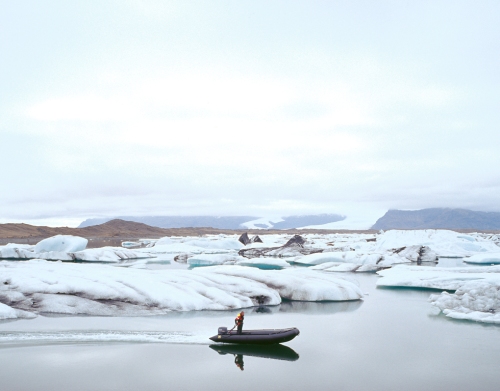
For full interview, please click on link below.
POP: What is your background and when did you start taking photos?
I started taking pictures at an early age. My dad always had a few cameras around and taught me how to use them . . . change the lenses, load the film, cock the shutter. I think at first I used them more as toys in various backyard adventures. I was interested in the mechanics of the camera but maybe didn’t grasp what you could do with it. It probably wasn’t until I was 11 that I used the camera consciously and sought things out to take pictures of.
POP: What was your process for developing your personal style?
I think my process could easily be reduced to looking and exploring. Venturing into the world with camera in hand and looking at everything I could from art books, to exhibits to movies to books. I can see traces of what I am doing today but it took time and study to become conscious of my own vision and aesthetic. It is a gradual process and a continuous exploration of self and the world around you.
I think you begin to identify what you like in the work of others before you can achieve that within your own work. I always wondered what would happen if you just never looked at anyone else’s work. Would it be better, worse? . . . hard to say. There was a period when I was looking at other work almost too much instead of just doing my own thing. I think I realized this though and decided to stop looking for a while. It is easy to see something and say, I like that, I want to do that, not because you want to copy it, but because it speaks to you. When a particular subject or style resonates it is important to explore why that is. You can start by dealing with the same issues that someone else was working through and if you keep at it the work all of a sudden becomes your own.
When you stop looking, however, you begin to look inward and this can change the work and even help you move forward. It is honestly a good exercise and I will continue to do it from time to time. The only problem is that I just love to look at images and other people’s work.
POP: You got signed with an agency fairly soon after photo school. What contributed to your early success?
A few factors: I worked with Dwight Eschliman in the later part of my time in graduate school. Both Dwight and I had studied under Lon Clark who came out of the New York Studio School and to me it made sense that I work with someone who was exposed to a similar mode of thinking about art. Dwight is an incredible photographer and his creativity, work, ethic and business model are all things to aspire to.
There were, however, some questions that I had about promotion that he deferred to his rep, Kelly Montez, of Apostrophe. Kelly was happy to look at my work and had some great feedback and ideas for editing. I think we were able to communicate really effectively right off the bat and establish a good dialogue. She helped put me in touch with some photo editors and art directors to begin showing my book. Some of them saw an application for my work so I ended up landing a few gigs right out of school.
I began to build relationships with these clients and Kelly was helping me out the whole time with estimating and guiding me through the process. After several jobs and a few rounds of meetings, she asked if we should make it official and it seemed to make a lot of sense for both of us as we already knew we could work really well together.
As a young photographer I am lucky to have a rep that believes in my vision and helps me foster that. Another critical factor is that when I first began to talk with Kelly I already had my website dialed in as well as a printed portfolio that was ready to show. Both of those have evolved drastically over the past two years but I think the point is that I at least had something with a real world application. I also continue to shoot and shoot which means I have a steady stream of new work to promote that demonstrates a devotion to what I am doing. I can’t imagine not creating something, no matter who is watching or who isn’t. I think part of what Kelly may have seen was a stubborn resolve to just drive forward with my own vision and maybe other people recognize that as well.
POP: Much of your work seems to deal with issues of preservation and loss and uses both subject matter and the medium of photography itself to explore these concepts. The results have so much humor and lightness though in dealing with a subject that could easily slide into the morbid. There’s just a sense of enjoyment through all of it.
I suppose the question is how does subject matter that could easily fall into the morbid become almost light or humorous? If that is the question I would say that morbidity is a part of life. Kafka succinctly said, “The meaning of life is that it ends.” We exist in a world of dichotomies and without the morbid we wouldn’t have the happy. I can’t really imagine a world without one or the other. Sometimes you have something that might not actually be funny but a certain amount of ridiculousness exists that makes you laugh. A dead animal isn’t funny in its own right but if you change the context it becomes something entirely different. It’s a difficult question. We laugh or cry for so many different reasons but to me they can be more similar than different. I think in order to live a full life you have to accept the morbid aspects of it. I don’t believe you need to celebrate the morbid but if you have a healthy understanding or acknowledgment of it, life can become a bit lighter.
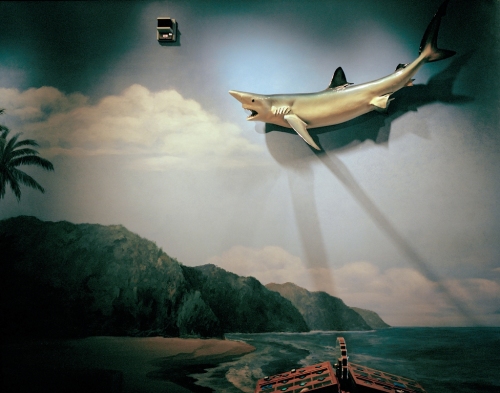
POP: How do you bring this to your editorial and commercial work?
I approach each situation uniquely. This may sound like a canned answer but I believe it is important to respect or at least understand the client’s needs and you might not always shoot something in exactly the way you want to. I always try to be authentic no matter what.
POP: A lot of your shots look like they are from 60’s film sets while other shots look very early ‘70’s. Why this era? How do you recreate this?
This is one of these things that I don’t know if I can fully explain because I honestly don’t quite know the answer. It is sort of like asking someone what their favorite kind of food is. There may or may not be concrete reasons why you like one thing and not the other. Taste seems to change naturally over time. I would say my taste at this moment is changing. At the beginning of school I was obsessed with the Dusseldorf School of Photography (Gursky, Demand, Struth, The Bechers). . . towards the end of school it was more the A.L.F.C.P (American Large Format Color Photographers. . .I made that up by the way) like Stephen Shore, Larry Sultan, and Joel Meyorwitz. . . now my taste has shifted more towards some Japanese photographers like, Kenro Izu and Kiriko Shirobayashi, Hiroshi Sugimoto and Kenji Toma.
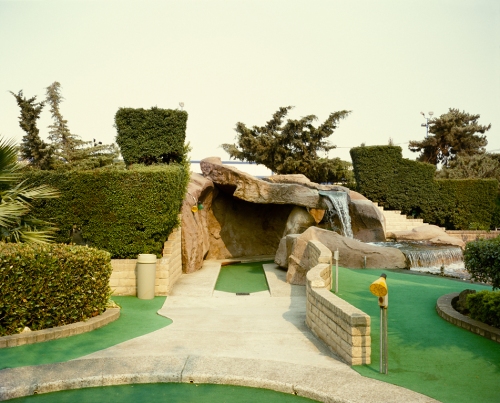
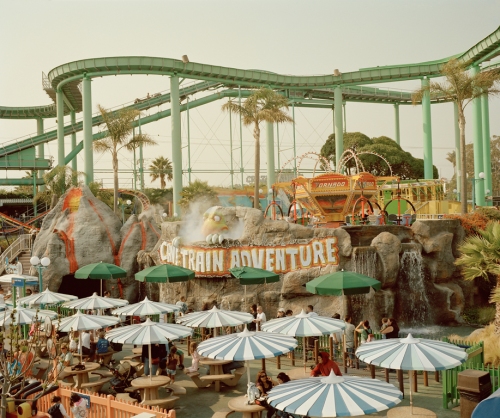
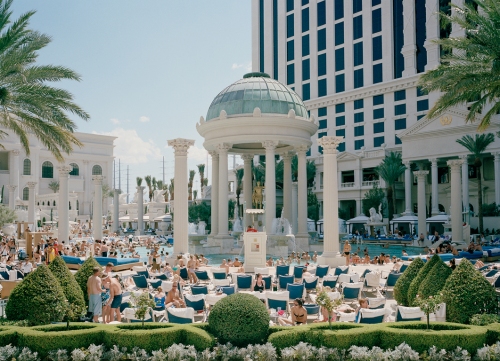
I have always been attracted to the work of some Dutch photographers . . . especially Maurice Scheltons, I can’t really say why. I can identify that I like the palette, the compositions, the subject matter, and so on, but I don’t really know why. Is it because of my mother’s European roots? Is it the art I saw when I was a little kid? The magazines or books I found in my grandparents’ house? I suppose all these things contributed to my taste and subsequent aesthetic.
POP: In your work, I see echoes of the photographers who have influenced you. But beyond that, something that seems to appear in many of your images is an otherworldly quality. As if they are manufactured dioramas of another place or time or parallel universe. But you find them here. I feel as if I’m being shown something I otherwise wouldn’t see, like you’re saying with a great sense of discovery ‘hey, look at this.’ As if you are sharing a very personal way of seeing the world with the hope that we’ll also see it like this.
The first thing I think about in answering this question is the “Decisive Moment” as delineated by Henri Cartier Bresson. It drives me slightly crazy when people talk about photography and that their purpose is wanting to capture a moment. That is inherent in the nature of photography. Is it not? So what else besides a moment? Half of photography is about time. Time and light. If a moment is inherent in the time aspect, then I think what we are left with is a feeling of that moment.
I think I am motivated by the feeling. I don’t necessarily walk through the world looking for moments but rather for a certain feeling. Sometimes a scene does seem surreal, like a dream or deja vu, or it carries an emotional quality of hope or lightness or something to that effect. It is the feeling that gives me pause and it is feeling that I search for that manifests in taking a picture.
In a metaphysical sense there are alternative worlds or universes all around us. Everything you don’t see is a world that didn’t exist for you. I just think that I look a lot, and search a lot, and because of that I find interesting things that people walk by every day. So many people don’t really look. I can’t believe how fast some people breeze through museums, or flip through books and magazines or just walk down the street with blinders on. The point is that all these surreal scenes exist in the world, you might just have to slow down a bit to see them.
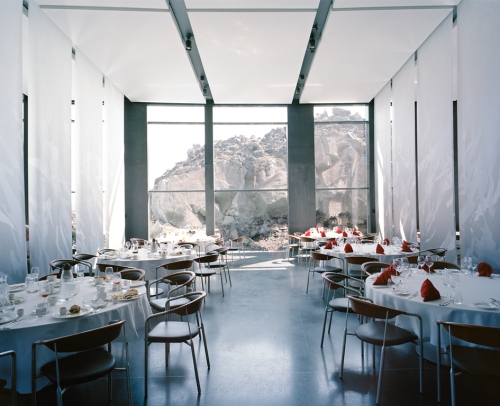
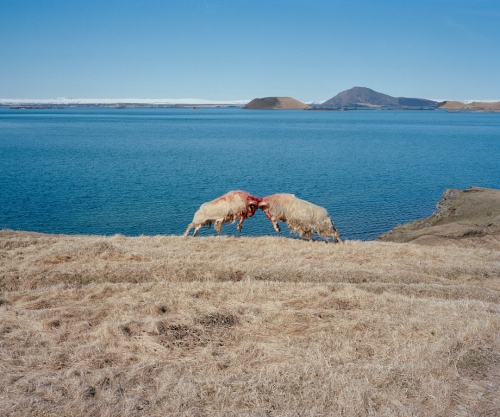
POP: Some of my favorite images on your site are the ones of the taxidermied animals, both in clean studio shots and in museum settings. What interests you about them? Taxidermy collection? Where do you get them?
The interest in taxidermy comes from childhood memories and some strange recurring dreams that I don’t want to delve into too much! It comes from going to natural history museums as well as reading stories about animals when I was a little kid. I think there is an innate sense to want to be close to our animal selves. Somehow this work deals with getting closer to that base animalism. Quite literally the closest you can get to an animal is sometimes in a museum/zoo setting.
It also has to do with the idea that the natural world is rapidly shrinking and we are left with this odd menagerie or relic that is completely disconnected from its natural context. We are so fascinated by nature but our ideas of it are often grossly distorted. I think a lot of this work is about sorting through what we are left with. Most of the taxidermy comes from different natural history museums that I have been building relationships with over the years and some (the more playful shots) come from local taxidermy shops.

POP: What’s the story behind the shot of the stand off between the armadillo and the beaver?
Well, that standoff was over a parking spot. The beaver won. He circled the armadillo twice and used his tail to flip the armadillo on his back. Then a hawk swooped in and grabbed the armadillo but I missed that because the shutter jammed. It was crazy.

POP: For your large-scale building-site photos, the images look like they’re shot with a 4×5. Again, they seem to reference a film process that is at risk of becoming obsolete. Are you trying to re-create the film aspect ratio or are they shot on film? And if in digital, what is behind the reference?
They are mostly shot with film and it is not so much a reference to, but a deliberate process and choice of medium. I am not really trying to re-create something. I think it is more about how I see or how I want to see and using the appropriate tools to achieve that.
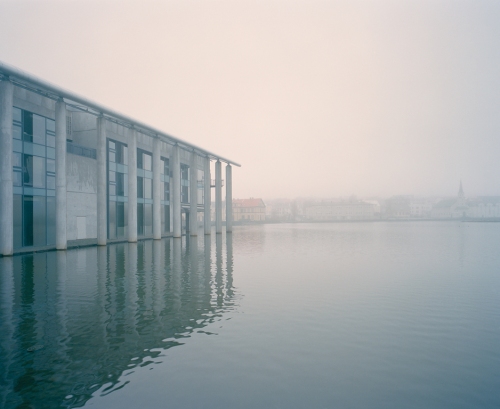

POP: You have quite a diverse portfolio and seem to be equally good at clean interiors for Scientific America and Dwell and studio shots as you are at shooting more evocative travel work for Ski magazine. How have you accomplished this while simultaneously working on developing a personal vision?
A lot of that comes down to the actual space or place. Each environment has its own peculiar feel and I try to be sensitive to that and shoot accordingly. I let it speak to me more often than bearing down on it with my own idea of how I think it should look. I often spend time in a place before I begin shooting just sitting on a couch or hanging out in a hallway, or walking from room to room kind of waiting for something to speak to me. Look; either way it is going to be my vision but standing on a beach in a bathing suit Vs. standing in a clean room donned in a bacteria free suit is going to feel entirely different and the work will reflect that.
I know that my work can feel different. I am conscious of that difference and for a while I was trying to force it into one bag but that may not be the right approach. Maybe it is naturally divergent and for now seems to be okay although it has probably confused a few people. I have shown my book in person to probably 100 or so people and they either comment on the difference or don’t. But in general they react very positively to the work. Maybe only 5% have been turned away because of this seeming divergence but most people just recognize the aesthetic difference and leave it at that. They will see an application or not and anyone that has a good understanding of the aesthetic they want or need will be able to see it and communicate that. I think it does raise an interesting question though of how I move forward. The easy answer is that I just shoot for myself and let others decide on the application.


POP: Your studio shots are meticulous. How did you shoot the still life’s of the plastic paper clip holders, the colored blocks and paper? All one shot?
Very carefully! And yes, all one shot.

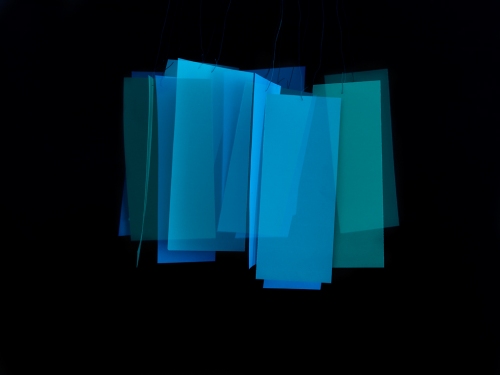
POP: You’ve said that you don’t do any compositing or HDR on your images. What is behind this choice?
Let me say that I think that digital photography is great. Let me also say that it can make people lazy. If you meter carefully, and wait or plan for the right light then you don’t necessarily need to use HDR or drastic digitizing effects/tools. I think it is also an aesthetic choice. Even though your eye has a very broad dynamic range you still don’t necessarily see detail in every shadow or highlight. I don’t quite know why you need to have detail across the entire image. I really do wonder who decided that. It is purely an aesthetic choice in my mind. I feel like there is a lot of work out there that looks more illustrative than photographic and that isn’t actually how things look. More and more it seems as if people are craving something real and you are starting to see more of that again.
It has to make sense for each individual application. I also like to embrace the limits of the medium. Isn’t it okay that film or a sensor can’t quite capture the entire dynamic range of a scene? That said, I still do bracket just to cover my bases and there have been cases when a client will ask, “Did you have something a bit lighter with detail?” and I can provide that. I also do compositing with certain images but in a way that is pretty subtle and maybe un-noticeable to most people. I actually think it is a great tool and can really change the way you think about creating an image. It allows you to do things you might not be able to accomplish otherwise and opens a lot to the imagination.
POP: What do you love to shoot when you’re not working?
It just depends on where I am . . . if the weather is crappy I like to work on still life . . . if it is nice I like to be out in the world exploring.

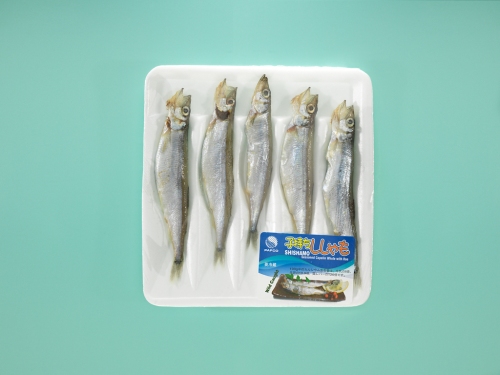
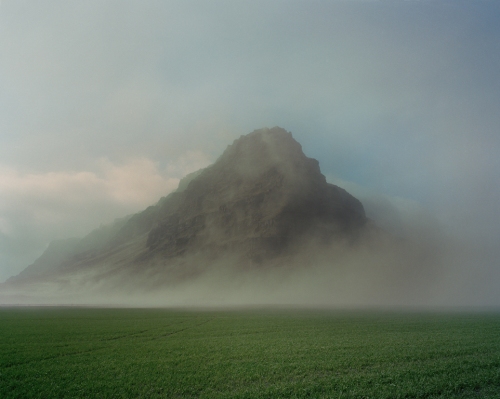
POP: Scale seems to figure quite prominently in your work. Even your “People” portfolio is filled with large-scale images that focus more on landscapes and environments with people in them, not on individual people. I always feel just a simple sense of awe with photos of this genre. Who/what are your inspirations?
Massimo Vitali and the painter John Dubrow figure most closely into the inspiration for this particular work although there are probably a few more on the list. I think the interest in this genre actually has more to do with color and scale than subject matter. There is something about the little bits of color in a larger landscape that I simply love. The impetus might be of a more visual nature and you end up finding these scenes in areas where people congregate en-mass like the beach or parks.
What is wonderful to me about this genre is that you can just enjoy the scene. The way the people are positioned in the frame, the feel of the landscape, but then you can also start to wonder about what is going on and see not only the visual relationships of things in the frame but the interpersonal relationships as well.
There are so many stories and forged histories happening in one space and I think that as the viewer you either consciously or unconsciously recognize this and it creates an immediate humanness. I feel awfully small in the world at times but there is a certain preciousness and beauty to that idea. I guess there is so much imagery that glorifies the individual but we can’t and don’t exist in the world alone. I feel that there is such a strong tie to our existence and the environment that is overlooked by far too many people.
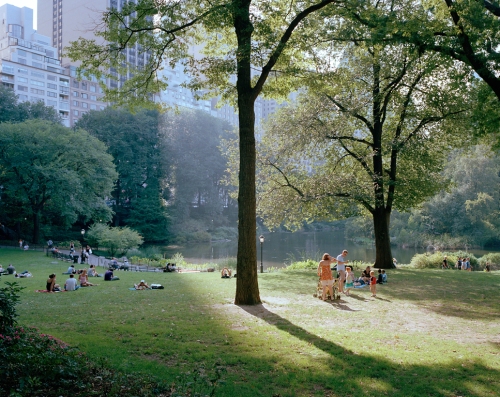
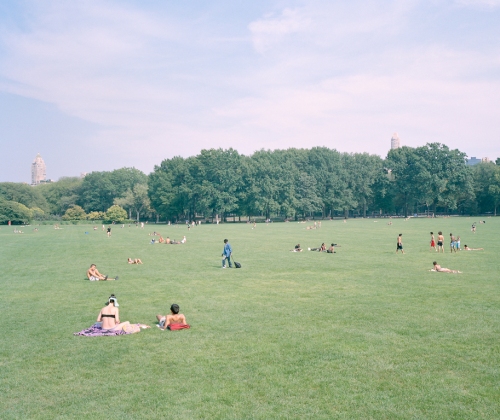
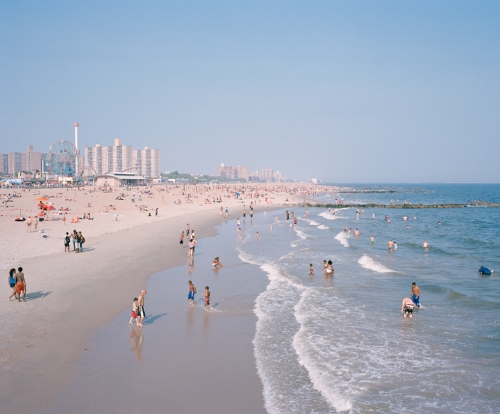
POP: Night landscapes are beautiful. What is your process? Long exposures? Composites?
Mostly just deliberate framing and careful exposures . . . no real trickery.
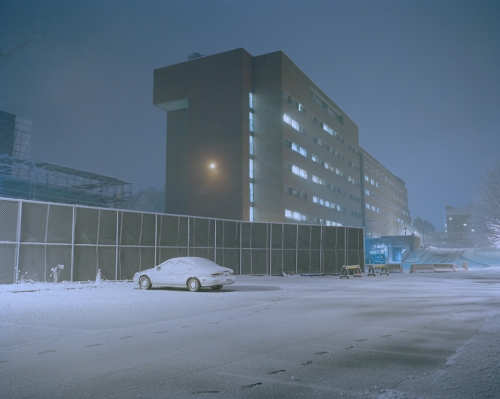

POP: Any jobs for which you’ve been hired for your style?
An Old Spice project I shot with W+K. The AD, Eric Baldwin, recognized the sort of surreal light and plastic quality my images convey and that was the feeling he wanted for the campaign. I think he also recognized some of the subtle humor in my images you mentioned before and that made sense for the tone of the ads. It was really incredible to be told to just do whatever it is you do.
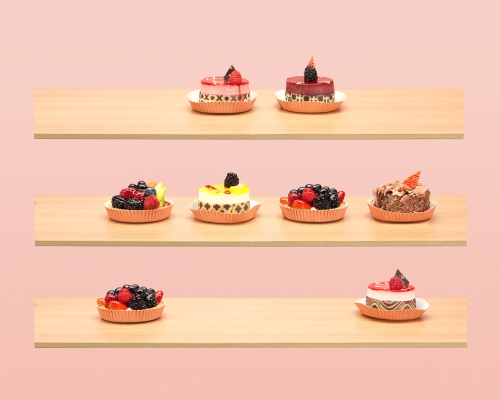
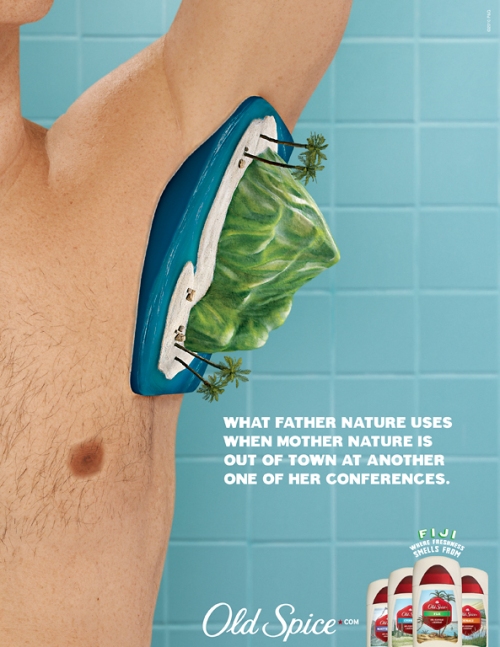
Old Spice for Weiden + Kennedy
POP: You are part of a collective here in San Francisco called The Black Harbor that includes photographers, designers and filmmakers. What is the mission of The Black Harbor? Do you collaborate on projects? And what are you working on now?
The Black Harbor is a collective of creatives from various disciplines. Most of the members were acquainted in one way or another in grad school. Some of us had collaborated on projects during school or just helped each other out. Say, Mike Jeter, who should be credited as the founder of The Black Harbor, needed some photographs, I would supply those and he would in turn help design a promo card or something. When school ended we all went our separate ways but it didn’t take long to recognize that we were still talking, sharing information and working together.
The Black Harbor is essentially a community made formal through the blog/blogazine format. We are continually discussing what works and what doesn’t and the direction we want to take it. We have been working on an artist interview series of our own but through video. People definitely seem to like these and the content ends up not just being about the person but about their involvement and philosophy which is pretty cool. The website is currently going through a redesign that should make it more reader friendly. A lot of people were saying, “We really like this, but what is it?” Well, we are working on that so just stay tuned!
POP: You very recently made the decision to step down as bass player for popular indie band Or, the Whale. I imagine this wasn’t an easy decision. What prompted this and how did you balance the two when you were doing both commercial photography and music?
No, this certainly wasn’t an easy decision. I have played music my entire life and the six other people I have been playing with are like family. I have been with them over five years but the time came to move on. I balanced the two pursuits for as long as I could. Sometimes I would have to miss practice or try and reschedule a show and sometimes I would have to miss out on a photo gig. That is how it panned out and it was easier to balance the two for the three years I was in graduate school.
The last two years got a bit trickier and it got to a point where I felt as if I would be holding myself back and holding the band back if I continued to do both. I am so happy though that the band will rock on and is doing really well, and I am lucky that everyone was so understanding through the process of stepping down. I will still be involved in music but just not in the same capacity.
POP: The collage series you did for San Francisco Magazine was really fun and a very successful use of this technique—the distortion was just enough so that the eye still moved around the buildings and spaces. How did you set those up? Did you plan each angle? All shot with same focal length? And how did you choose the focal length?
Alejandro Chavetta, the AD, wanted to do something different for a story about hotels and get-aways in Northern California. We talked about possible ways to approach it and arrived at the idea of doing a collage of sorts. We referenced David Hockney and kind of used his pioneering work as a starting point. I hit the road for a week and by mid-day on the first shoot was doing mock-ups on location and sending them back and forth to finally arrive at a loose formula of how it would work. One lens and one focal length. We worked out that 15 – 18 shots fit into each plate.
The idea was to see details of the scene while also being able to take in the grandeur of the entire scene. I think this actually mimics how we see things. When looking at a landscape or even a room you can see its entirety but to see detail you have to focus on one part of that larger scene. Try it! That was essentially the concept. Lets not put something into a neat little frame. Lets look at not only what is inside the frame but what is outside the frame and somehow put those things together. I think it worked out really well in the end and I especially have to applaud Alejandro for taking a risk and trying something new.
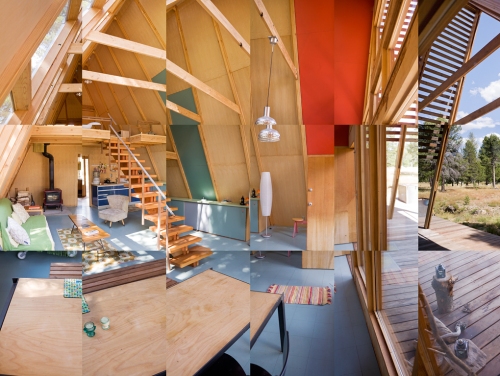
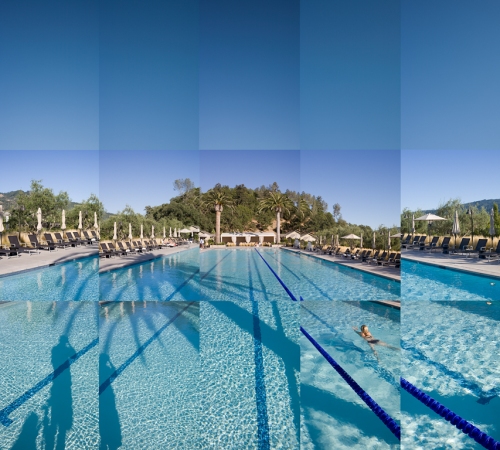
POP: You have a lot of travel photography on your site. Do you pick destinations you want to photograph?
There are so many places I would like to go and take pictures. I don’t think there is any place I wouldn’t go. I was in Iceland this past spring and am working on putting a book together with those images. I actually didn’t find what I expected and that was very frustrating at first. It took some time to let go of my expectations and start seeing what was in front of me. I was there during a very liminal time and the place was empty and it was foggy and cold and brown. I would like to go back this winter. I have some friends living in Europe this year so possibly I will stop through on my way to visit them. I definitely feel a pull to explore the Alps at some point, China, Greenland, Madagascar, yea, pretty much anywhere!
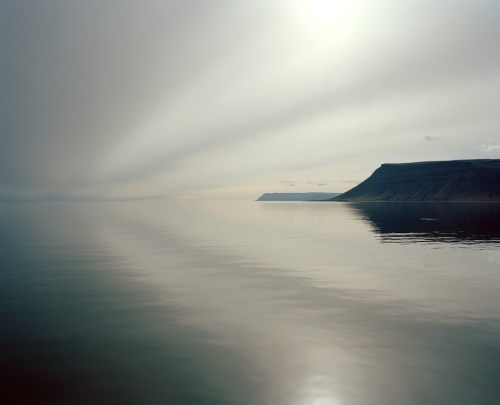

A big thank you to Justin for a wonderful interview.
Filed under: advertising photographer interview, editorial photographer interview, photographer interview | 1 Comment
Tags: andreas gursky, apostrophe reps, dusseldorf school, dwight eschliman, hiroshi sugimoto, joel meyerowitz, justin fantl, kelly montez, kenji toma, kenro izu, kiriko shirobayashi, larry sultan, lon clark, maurice scheltons, San Francisco advertising photographer, San Francisco Editorial Photographer, San Francisco Still Life Photographer, san francisco travel photographer, stephen shore, thomas demand bernd and hilla becher, thomas struth, travel photography
One Response to “Q&A with Photographer JUSTIN FANTL”